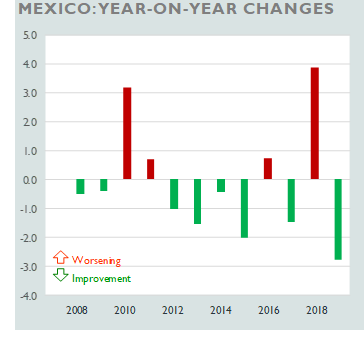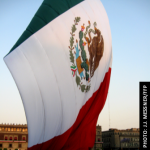BY MCKENZIE HORWITZ
In the previous edition of the Fragile States Index (FSI), Mexico was the most worsened country — a decline in Mexico’s economy, the deteriorating status of refugees, and prevalent political corruption had pushed the country to the 88th position on the FSI in 2017, its worst ranking in over a decade. Indeed, Fund for Peace covered Mexico’s rapid decline in an article entitled, “So Far from God, So Close to the United States: Mexico Most-Worsened in 2017.”
However, in a surprising twist, in 2018 Mexico has recovered to become FSI’s sixth-most improved country overall, showing moderate improvements across nearly every indicator. This dramatic shift is largely attributable to the country’s resilience in the face of worsening U.S.-Mexican relations and the benefits reaped from overall improvements in its southern neighbors in Central America. In the face of very low expectations for its success in 2017, Mexico demonstrated continued economic strength and resilience.
 During the campaign of U.S. President Donald J. Trump, in which Mexico and Mexicans were widely vilified, few thought Mexico would be able to weather his proposed “America First” policy agenda. The Mexican Peso saw a 11% crash in value immediately following the U.S. election. However, by the end of 2017, the Peso had more than recovered in value and the country’s economic growth had been preserved by the continued strength of Mexico’s automotive industry, the second largest in the Western Hemisphere. This sector alone saw 13% growth in 2017 compared to 0.9% growth the previous year.[1]
During the campaign of U.S. President Donald J. Trump, in which Mexico and Mexicans were widely vilified, few thought Mexico would be able to weather his proposed “America First” policy agenda. The Mexican Peso saw a 11% crash in value immediately following the U.S. election. However, by the end of 2017, the Peso had more than recovered in value and the country’s economic growth had been preserved by the continued strength of Mexico’s automotive industry, the second largest in the Western Hemisphere. This sector alone saw 13% growth in 2017 compared to 0.9% growth the previous year.[1]
Since the U.S. market accounts for 80% of Mexican exports and nearly half of Mexican imports, President Trump’s anti-NAFTA rhetoric posed a serious threat to Mexico’s economy. In 2017, Mexico responded by diversifying its trading partners and, therefore, reducing their future dependence on U.S. agriculture. The country increased their imports of corn from Brazil ten-fold[2] and signed a trade deal with Argentina to import wheat.[3] The country has also begun talks with the European Union to expand and modernize their existing free trade agreement.[4] By forging new trade partnerships, Mexico’s leaders have taken important steps that will only build on the economic strengths that have been demonstrated by its manufacturing sector.
In the 2017 FSI, Mexico’s most-worsened indicator was Refugees and IDPs, largely due to the Central American refugee crisis which saw refugees from El Salvador, Guatemala, and Honduras fleeing to, and through, Mexico. However, the 2018 FSI shows that each of these countries has seen significant improvements, reducing the pressure on Mexico, whose authorities had reported apprehending 27% fewer Central American migrants on its southern border in the first two months of 2017 than in the same period the previous year.[5]
Increased support from the international community also contributed greatly to Mexico’s ability to manage the refugee crisis in 2017. Though asylum applications in Mexico continued to rise in 2017, this mainly reflected the growing number of civil society groups working to register refugees. UNHCR increased support for the refugees by opening new field offices along the Mexico-Guatemala border and in areas of forced displacement in Honduras.[6] Additionally, the Inter-American Development Bank pledged US$750 million toward key infrastructure projects in the Northern Triangle.[7] The U.S. Congress also approved a US$655 million package as part of the Alliance for Prosperity formed with heads of state in the Northern Triangle which aims to support anti-crime and anti-corruption initiatives in El Salvador, Guatemala, and Honduras.
Mexican leaders also remained determined to not allow the U.S. administration’s evolving immigration agenda to overburden Mexico’s immigration apparatus. In President Enrique Peña Nieto’s first call with President Trump, he made it clear that Mexico would not pay for the proposed wall along the Mexico-U.S. border. When the United States released an outline for mass deportations of undocumented immigrants into Mexican territory in early 2017, the country again responded with strong objections and plans to refuse any non-Mexican deported into the country from the United States.[8]
Despite the emerging rift between American and Mexican diplomats, Mexico has exceeded expectations in its ability to push back at its northern neighbor’s evolving immigration platform and to manage the consequences of the Central American refugee crisis.
Despite Mexico’s resilience in 2017, the nation still faces challenges in the year to come. Violent crime remains a challenge as levels rose again in 2017 which was reflected in Mexico’s Security Apparatus score of the 2018 FSI. The country was also named the most dangerous for journalists in 2017 by the International Press Institute and recorded its highest homicide rate in decades.[9] Corruption continues to plague the political sphere as Mexico nears its presidential elections in July 2018. By the fall of 2017, 11 of the country’s 32 governors were under investigation or facing charges for corruption.[10] Nearly 90% of Mexicans see the state and federal governments as deeply corrupt, which has eroded the base of President Peña Nieto’s Institutional Revolutionary Party (PRI).[11] This shift is clear in the rise of presidential frontrunner Andres Manuel Lopez Obrador of the National Regeneration Movement (Morena), who is promising a return to state ownership, business subsidies, and agricultural self-sufficiency.
Though Mexico appears to have managed to weather the political and diplomatic storm resulting from the election of President Trump, its long-term resilience will still be tested by the entrenched problems of violence and corruption. Whether or not the country can eradicate corruption will greatly impact the nation’s state legitimacy, and its ability to deal with the threat of violence will similarly impact its stability. U.S. administrations come and go, however, Mexico’s ability to demonstrate resilience against its more domestic challenges will ultimately decide the trajectory of Mexico’s performance over the longer term.
ENDNOTES
1. World Integrated Trade Solution. World Bank. Country Snapshot, Mexico.
2. Huffstuffer, Barrera. 2018. “Exclusive: As Trump Trashes NAFTA, Mexico Turns to Brazilian Corn,” Reuters, February 22.
3. USDA Foreign Agricultural Service. 2017. Global Agricultural Informational Network Report. “Mexico to Begin Importing Argentine Wheat,” October 23.
4. Michael Birnbaum. 2017. “Mexico looks to Europe and beyond for free-trade allies as NAFTA falters,” Washington Post, December 19
5. Nina Lakhani. 2017. “Asylum applications in Mexico have soared 150% since Trump’s election,” The Guardian, April 28.
6. UN High Commissioner for Refugees. 2017. “Northern Triangle of Central America Situation Factsheet,” February.
7. Inter-American Development Bank. 2017. “IDB Group pledges $750 million for key infrastructure projects in the Northern Triangle,” June 14.
8. Alan Abramson. 2017. “Trump Urged Mexico’s President to Stop Opposing His Wall Plan,” New York Times, August 3.
9. Steven M. Ellis, 2017. Mexico most deadly country for journalists in 2017, December 19.
10. Luis Gómez Romero. 2017. “Governors gone wild: Mexico faces a ‘lost generation’ of corrupt leaders,” The Conversation, August 15.
11. Freedom House. 2018. Mexico. Freedom in The World 2018 Report.
